Technology can be viewed as one of humanity’s greatest gifts. It has dramatically impacted our lives and permeated every facet of the business world. The field of healthcare is no different. In truth, implementing technology in the healthcare industry has by far been the most important and fruitful.
As of now, the adoption of technology has made it easier for healthcare providers to collect data in a more refined manner, explore various treatment methods, reduce errors, and discover new tools to practice medicine. In addition to this, patient-doctor communication has also improved. How? Patients can now seek treatment, disease education, and medicine recommendations and book consultations and appointments with their doctors through online portals.
But that’s just the tip of the iceberg, as the healthcare industry is continuously experiencing technological breakthroughs and improving patient outcomes. Interested in learning more? To that end, here’s a gist of how technology is rapidly improving healthcare:
-
Electronic Health Records (EHRs)
Electronic Health Records (EHRs) are digital versions of patients’ health information stored in a centralized database. EHRs allow healthcare providers to access and share patient information in real-time, making it easier for them to coordinate care. EHRs also reduce the risk of medical errors, as patients’ health information is always up-to-date and accessible to all their providers. Furthermore, many different types of electronic record-keeping systems are available to store, manage, and process data from all states of medical tests and procedures. If you work for a healthcare facility keen on investing in a reliable system, try NovoPath’s laboratory information system and improve coordination between outpatient and inpatient medical procedures. It helps streamline information management and integrate various clinical specialties for standardized care.
Augmented reality surgical navigation
This technology has revolutionized the field of surgery by providing real-time, dynamic guidance during procedures. By overlaying digital information onto the surgeon’s view, this technology enhances precision and accuracy, reducing the risk of errors and improving patient outcomes. Augmented reality surgery allows surgeons to visualize critical anatomical structures, such as blood vessels and nerves, in relation to the patient’s body, aiding in complex surgeries and minimally invasive procedures. The technology enables surgeons to plan and execute surgical interventions with greater confidence, leading to shorter operation times and reduced complications. Furthermore, augmented reality surgical navigation facilitates training and education by providing immersive experiences for surgical residents and allowing for real-time guidance from experts in remote locations. Overall, this technology represents a significant advancement in surgical precision, safety, and efficiency.
-
Telemedicine
Telemedicine, or “virtual healthcare,” is one of the most significant ways technology changes healthcare. With telemedicine, patients can consult with their healthcare providers through video conferencing, phone calls, or messaging without visiting a physical location. Consequently, this makes healthcare more reachable, especially for people with mobility issues or those who live in rural areas. It also reduces the spread of infectious diseases and reduces healthcare costs.
-
3D printing
The days when an unavoidable and painful amputation followed a broken bone are long gone. Today’s 3D printing technology allows medical practitioners to recreate replicas of bones and other remarkably lifelike parts. These models are of immense use to surgeons when replacing bones and other damaged areas. To understand what is happening inside a patient’s body, doctors frequently use 3D printing as a tool. In the beginning, the surgeon can virtually observe the main trouble areas.
Additionally, they can test out various therapies and procedures on these models before operating on a patient. This makes it simpler to carry out life-saving procedures quickly and effectively. Similarly, doctors can create low-cost prosthetics, particularly for patients from developing countries, and prescribe their patients individualized medicinal items. Doctors use models created via 3D printing to train surgical interns. These function exactly like driving simulators for cars. A training method like this accelerates the development of intern abilities.
-
Artificial Intelligence (AI) in Diagnostics
Artificial intelligence (AI) is increasingly important in the healthcare industry, particularly diagnostics. AI algorithms can analyze vast amounts of data, including medical images and lab results, to help healthcare providers make more accurate diagnoses. In some cases, AI can identify medical conditions faster and more accurately than human doctors. This improves the quality of care, saves time, and reduces healthcare costs.
-
More Effective Patient Education
Long ago, patient education depended on written materials about medication, disease processes, medical management, and self-care instructions. Today, people may get health information from anywhere, thanks to technology. Patients can now contact a medical provider anytime they need one because of advancements in telemedicine. Patient alternatives for consuming health information and increasing their level of involvement in their care include educational movies, interactive walkthroughs, and text reminders.
Additionally, enhanced functionality in already-existing technology, such as patient portals, can give patients personalized health education material based on their requirements and situations. It is not surprising that most doctors are adopting technologies that can assist in better educating and engaging patients because patient education is taking on a greater significance in healthcare.
-
Tools for Remote Monitoring
Patients would avoid needless doctor appointments and save a significant amount of money if they could check their health at home. Patients with heart conditions can program devices like pacemakers to communicate information to medical facilities. Also, there are systems designed specifically for patients with chronic diseases that allow hospitals to monitor patients’ health from any location.
These instruments oversee the monitoring improvements and health breakdowns of patients with prior problems needing keen and careful supervision, which reduces the workload by half. Another benefit is that they can bill and record this information.
-
Big Data Analytics
Big data analytics is revolutionizing how healthcare providers analyze patient data to improve patient outcomes. By analyzing vast amounts of patient data, healthcare providers can identify patterns, trends, and correlations that can help them make more informed decisions about patient care. This not only improves patient outcomes but also helps to reduce healthcare costs.
-
Robotic Surgeries
In the past, the concept of a robot doing surgery would have looked like something out of a sci-fi movie. But today, it is not only common but also highly advised. Surgeons’ skills can only reach so many of the human body’s deep, challenging regions. However, robots are unconstrained; they can go anywhere humans cannot. This slight distinction has led to more effective surgery than ever before. For instance, some surgeons employ robots to help them during procedures to remove brain tumors. The surgeon used a sophisticated robotic microscope in a recent example of a juvenile patient. The tool, according to the doctor, included:
- A robotic arm.
- A GPS feature that showed where his instruments were.
- A heads-up monitor that provided a better view of the operating region.
Conclusion
Based on the above information, it wouldn’t be an understatement to say that technology can help save lives more effectively. Thanks to the advent of technology, there are now better treatment options available, and the scope of overall care is also experiencing a massive boost. Over time, more software and systems will be available to streamline workflow, provide excellent care to patients, and reduce the margin of error. Furthermore, to keep up with the changing times, all doctors, physicians, and nurses must learn to adapt to technology and join the pursuit of providing quality healthcare.


































































![SUSHI Price Prediction 2025-2030 [ Crypto Investors’ Guide ] SUSHI Price Prediction](https://www.apzomedia.com/wp-content/uploads/2022/06/SUSHI-Price-Prediction-100x70.jpg)
